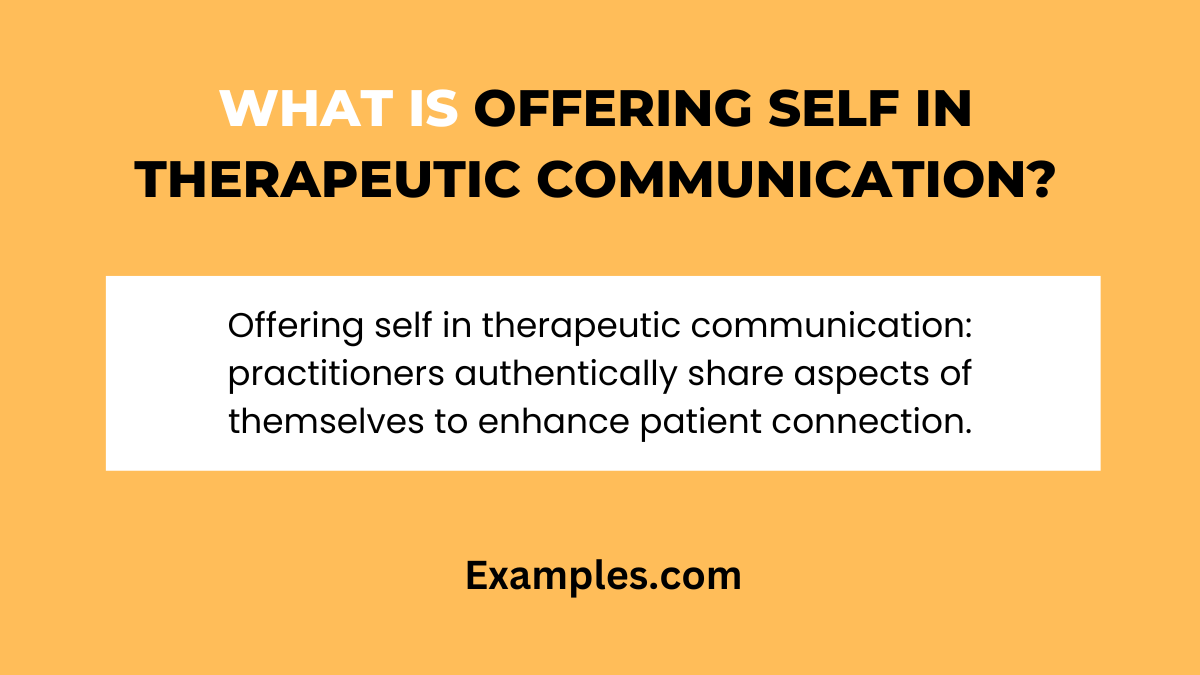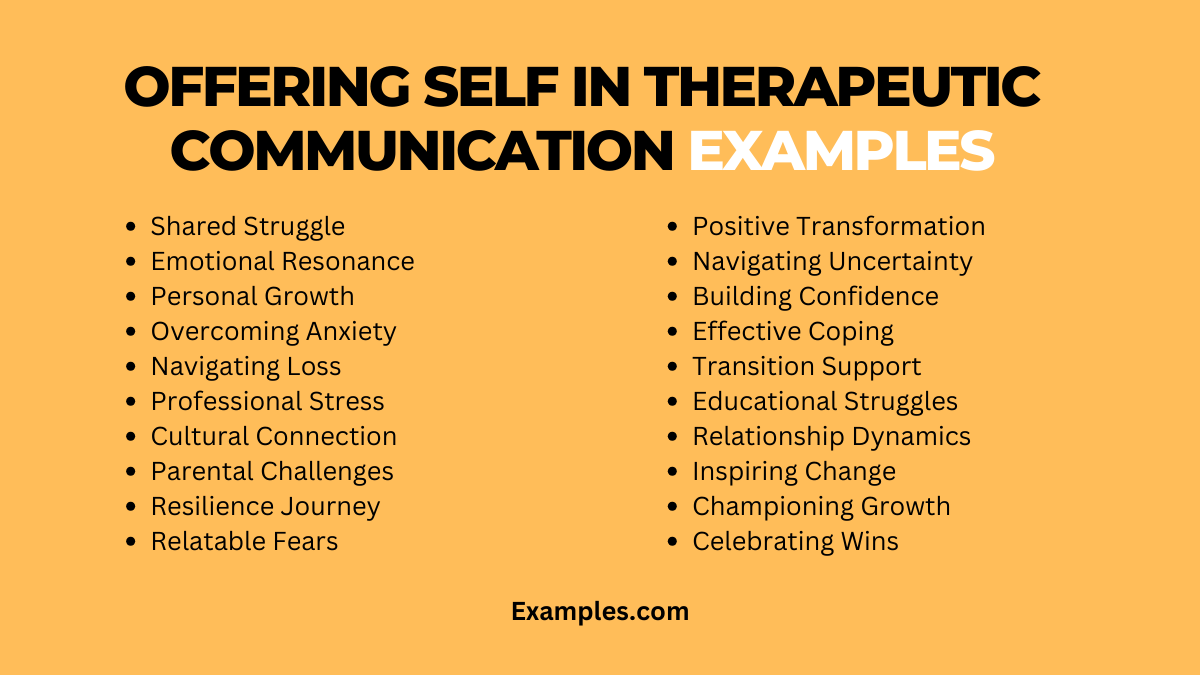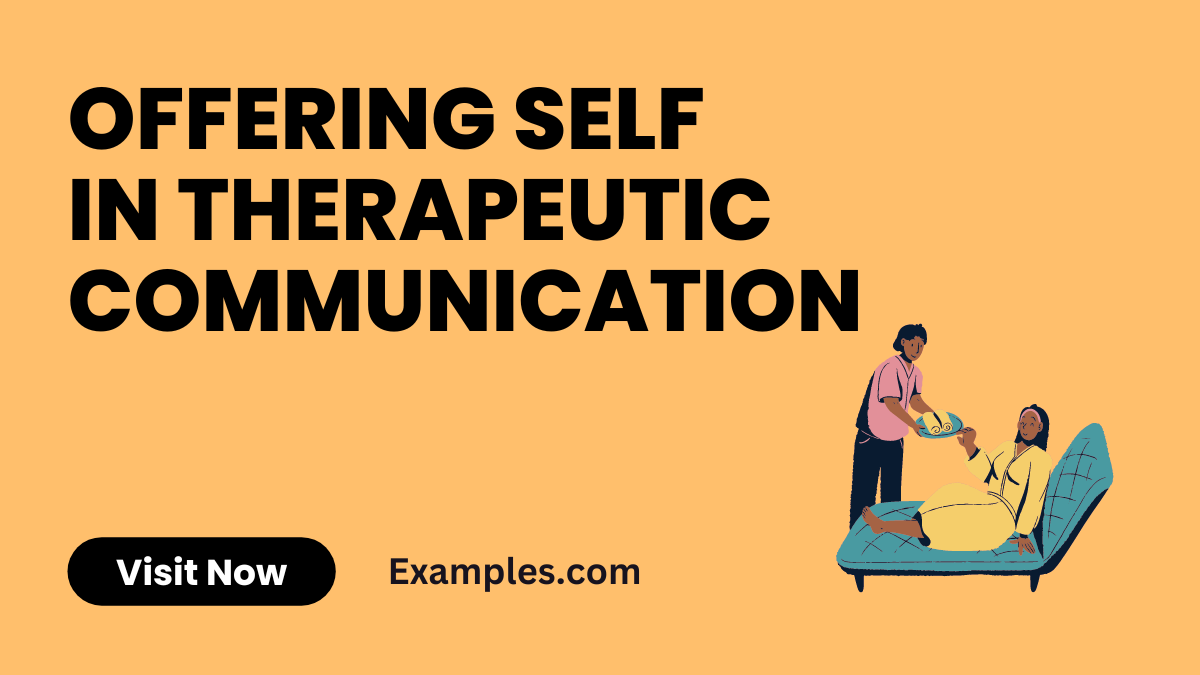19+ Offering Self in Therapeutic Communication Examples
Unlock the transformative power of Offering Self in Therapeutic Communication! Dive into our comprehensive guide, enriched with Communication Examples that illuminate the art of genuine connection. Elevate your skills, grasp effective techniques, and navigate the nuances of compassionate communication to foster profound therapeutic relationships. Explore real-world scenarios that showcase the impactful synergy between practitioners and individuals, and master the delicate balance of self-disclosure for therapeutic effectiveness.
What is Offering Self in Therapeutic Communication?

Offering Self in Therapeutic Communication involves practitioners authentically sharing aspects of their own experiences, emotions, or insights to establish a deeper, empathetic connection with individuals in therapy. This intentional self-disclosure fosters trust, enhances rapport, and creates a safe space for open dialogue, contributing to the therapeutic process.
20 Offering Self in Therapeutic Communication Examples

In Offering Self in Therapeutic Communication, practitioners may share personal experiences, struggles, or triumphs to resonate with individuals in therapy. This intentional self-disclosure can help normalize feelings, strengthen the therapeutic alliance, and provide a relatable context. By offering insights from their own journey, practitioners create a collaborative and empathetic environment, promoting trust and facilitating a deeper understanding of the client’s experiences. This approach enhances the therapeutic process by fostering connection and mutual vulnerability.
- Shared Struggle: “I faced challenges too. Let’s navigate your struggles together, finding strength in our shared journey.”
- Emotional Resonance: “I’ve felt that too. Let’s explore your emotions, creating a space where vulnerability is welcomed.”
- Personal Growth: “I’ve grown from setbacks. How can your challenges contribute to your personal growth?”
- Overcoming Anxiety: “I’ve coped with anxiety. Let’s discuss coping mechanisms to ease your anxious moments.”
- Navigating Loss: “I’ve experienced loss. Let’s navigate your grief journey and find solace together.”
- Professional Stress: “Work stress is real. Let’s explore strategies to maintain professional well-being.”
- Cultural Connection: “As someone with a diverse background, I understand the importance of cultural sensitivity.”
- Parental Challenges: “As a parent, I empathize with your concerns. Let’s address challenges and celebrate victories.”
- Resilience Journey: “I’ve faced setbacks. Let’s focus on your resilience journey and celebrate your progress.”
- Relatable Fears: “Facing fears is universal. How can we work together to overcome your specific fears?”
- Positive Transformation: “I’ve experienced change. Let’s envision and work toward positive transformations in your life.”
- Navigating Uncertainty: “Life’s uncertainties are challenging. Let’s navigate them together, fostering a sense of security.”
- Building Confidence: “I’ve overcome self-doubt. Let’s explore your strengths and build your self-confidence.”
- Effective Coping: “Coping mechanisms matter. Let’s discover and implement strategies for effective coping.”
- Transition Support: “Navigating transitions is tough. How can we make this transition smoother for you?”
- Educational Struggles: “School challenges are common. Let’s develop effective coping strategies for academic stress.”
- Relationship Dynamics: “I’ve faced relationship challenges. Let’s explore healthy dynamics for your relationships.”
- Inspiring Change: “I’ve embraced change. How can we inspire positive changes in your life?”
- Championing Growth: “I’ve embraced personal growth. Let’s champion your journey toward becoming your best self.”
- Celebrating Wins: “Successes are worth celebrating. Let’s acknowledge and build on your achievements together.”
Offering Self in Therapeutic Communication Examples Nursing
In the healthcare setting, practitioners may share relevant personal experiences to establish connection and empathize with patients. By judiciously offering insights into their own challenges and triumphs, nurses foster a therapeutic alliance, promoting patient trust and engagement. This technique enhances the overall care experience, creating a supportive environment.
- Boldly Relating: “I faced a similar health challenge. Understanding your concerns, let’s navigate this journey together.”
- Shared Resilience: “I’ve overcome illness myself. Your resilience reminds me of my journey. How can I assist you?”
- Empathy Bridge: “I too felt overwhelmed during treatment. Share your concerns, and we’ll find a path forward.”
- Navigating Uncertainty: “I’ve been in uncertain health situations. Let’s discuss your concerns openly and find clarity.”
- Encouraging Shared Experiences: “I’ve witnessed patients overcome similar struggles. Let’s explore your unique path to recovery.”
Offering Self in Therapeutic Communication Examples Technique
Utilizing this technique involves sharing pertinent personal experiences to enhance therapeutic connections. Practitioners employ discretion, ensuring relevance and appropriateness. This intentional self-disclosure aids in building rapport, fostering a collaborative atmosphere, and validating clients’ experiences, contributing to a more profound therapeutic alliance.
- Building Rapport: “I’ve faced challenges too. Let’s connect on a deeper level to strengthen our therapeutic bond.”
- Validation through Sharing: “Sharing my experiences may help you feel understood. How can we tailor our sessions to your needs?”
- Mutual Vulnerability: “I’ve navigated similar emotions. By sharing, I hope to create a space for open dialogue and understanding.”
- Enhancing Relatability: “My journey may resonate with yours. Let’s leverage these shared experiences for your therapeutic growth.”
- Fostering Connection: “Through sharing, I aim to build trust. Let’s discuss how this can enrich our therapeutic relationship.”
What is the Concept of Offering Self in Therapeutic Communication?

Offering oneself in therapeutic communication involves a deliberate and empathetic sharing of the practitioner’s personal experiences, feelings, or insights with the patient. This intentional self-disclosure aims to build rapport, foster trust, and create a more profound therapeutic alliance. It’s a delicate balance, emphasizing the practitioner’s authenticity while maintaining professional boundaries.
How Offering Self in Therapeutic Communication is Helpful for Patients?
The act of offering oneself in therapeutic communication can be immensely beneficial for patients. It creates a human connection, reassuring patients that they are not alone in their struggles. This technique promotes a sense of shared understanding, as practitioners relate their experiences to patients’ challenges. This relatability enhances trust, encourages open communication, and contributes to a more collaborative therapeutic relationship.
What is the Importance of Offering Self in Therapeutic Communication?
- Establishing Trust: Offering oneself fosters a sense of trust between the practitioner and the patient. The willingness to share personal experiences demonstrates vulnerability, encouraging patients to reciprocate and engage more openly.
- Enhancing Empathy: Patients often appreciate practitioners who can empathize with their experiences. By offering personal insights, practitioners demonstrate a genuine understanding of the emotional aspects of the patient’s journey.
- Facilitating Connection: The concept of offering oneself creates a connection beyond the professional realm. Patients feel a deeper connection with practitioners who share relatable experiences, fostering a more supportive and collaborative therapeutic environment.
- Encouraging Open Communication: When practitioners offer themselves, patients may feel more comfortable expressing their thoughts and emotions. This open communication is crucial for exploring and addressing the underlying issues contributing to the patient’s well-being.
- Validating Patient Experiences: Through intentional self-disclosure, practitioners validate patients’ experiences. This validation is empowering and contributes to a patient’s sense of self-worth and resilience.
- Building a Therapeutic Alliance: The overall importance lies in building a strong therapeutic alliance. Offering oneself is a tool to establish a genuine connection, essential for effective therapeutic communication and positive patient outcomes.
In conclusion, offering oneself in therapeutic communication emerges as a powerful tool, fostering profound connections and enhancing patient outcomes. Balancing authenticity with professional boundaries, practitioners create a therapeutic alliance built on trust and empathy. With its ability to encourage openness and validate patient experiences, this practice stands as a cornerstone in establishing a collaborative and supportive healing environment.



